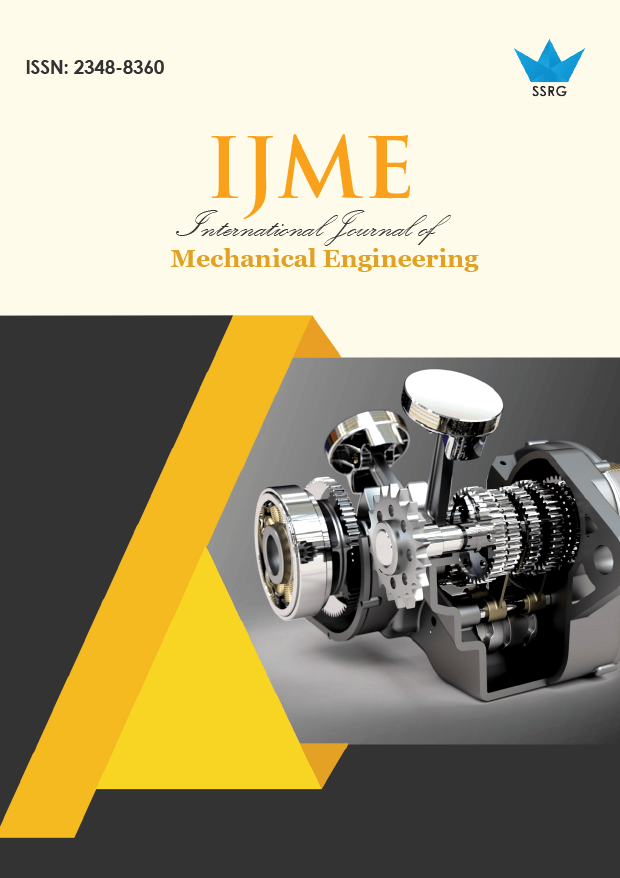Effect of Different Biodiesel blends (80% Diesel + 20% Biodiesel) on Tribological Property of I.C. Engine Components

| International Journal of Mechanical Engineering |
| © 2020 by SSRG - IJME Journal |
| Volume 7 Issue 10 |
| Year of Publication : 2020 |
| Authors : Dr. Venkata Sundar Rao K, Dr. Shreeprakash B |
How to Cite?
Dr. Venkata Sundar Rao K, Dr. Shreeprakash B, "Effect of Different Biodiesel blends (80% Diesel + 20% Biodiesel) on Tribological Property of I.C. Engine Components," SSRG International Journal of Mechanical Engineering, vol. 7, no. 10, pp. 7-10, 2020. Crossref, https://doi.org/10.14445/23488360/IJME-V7I10P102
Abstract:
The internal combustion engine is a heat engine that converts chemical energy into mechanical energy, usually made available on a rotating output shaft. The fuel’s chemical energy is first converted to thermal energy using combustion or oxidation with air inside the engine. This thermal energy raises the gases’ temperature and pressure, and the high-pressure gas then expands against the engine’s mechanical mechanisms. The machine’s mechanical linkages convert this expansion to a rotating crankshaft, which is the engine’s output. In turn, the crankshaft is connected to a transmission and power train to transmit the rotating mechanical energy to the desired final Use. For engines, this will often be the propulsion of a vehicle. The wear test reveals the effect of different Biodiesel blends (80%Diesel + 20%Biodiesel) on Tribological Property of I.C. Engine components viz., piston, piston rings, and cylinder liner. From the above discussions, it is evident that a blend of 80% diesel + 20% Hippe oil has better lubrication properties than diesel and other combinations of biodiesels considered.
Keywords:
Diesel, Hippe oil, Surface roughness
References:
[1] WANG Wenzhong, HU Yuanzhong, WANG Hui& LIU Yuchuan, Numerical simulation of a piston ring in the mixed lubrication, State Key Laboratory of Tribology, Tsinghua University, Beijing 100084, China, 2001.
[2] O M I NWAFOR, Knock characteristics of dual-fuel combustion in diesel engines using natural gas as primary fuel, 27(3) (2002) 375–382.
[3] A.S. Ramadhas, S. Jayaraj, and C. Muraleedharan, Use of vegetable oils as I.C. engine fuels, Renewable Energy 29 (2004) 727–742.
[4] Avinash Kumar Agarwal, Biofuels (Alcohols and Biodiesel) applications as fuels for internal combustion engines, Progress in Energy and Combustion Science 33 (2007) 233–271.
[5] Maro JELIĆ and Neven NINIĆ, et al., Analysis of Internal Combustion Engine Thermodynamic Using the Second Law of Thermodynamics, Strojarstvo 50 (2) (2008) 85-94.
[6] C D Rakopoulos, E G Giakoumis, and DC Rakopoulos, Study of the short-term cylinder wall temperature oscillations during transient operation of a turbocharged diesel engine with various insulation schemes, 4 February 2008.
[7] Mr. Venkata Sundar Rao. K, Dr. S.N. Kurbet, Dr. Vinay V. Kuppast, Study of the Effect of Biofuel on Tribological Property of IC Engine Components, SSRG International Journal of Mechanical Engineering 4.2 (2017): 1-6.

 10.14445/23488360/IJME-V7I10P102
10.14445/23488360/IJME-V7I10P102